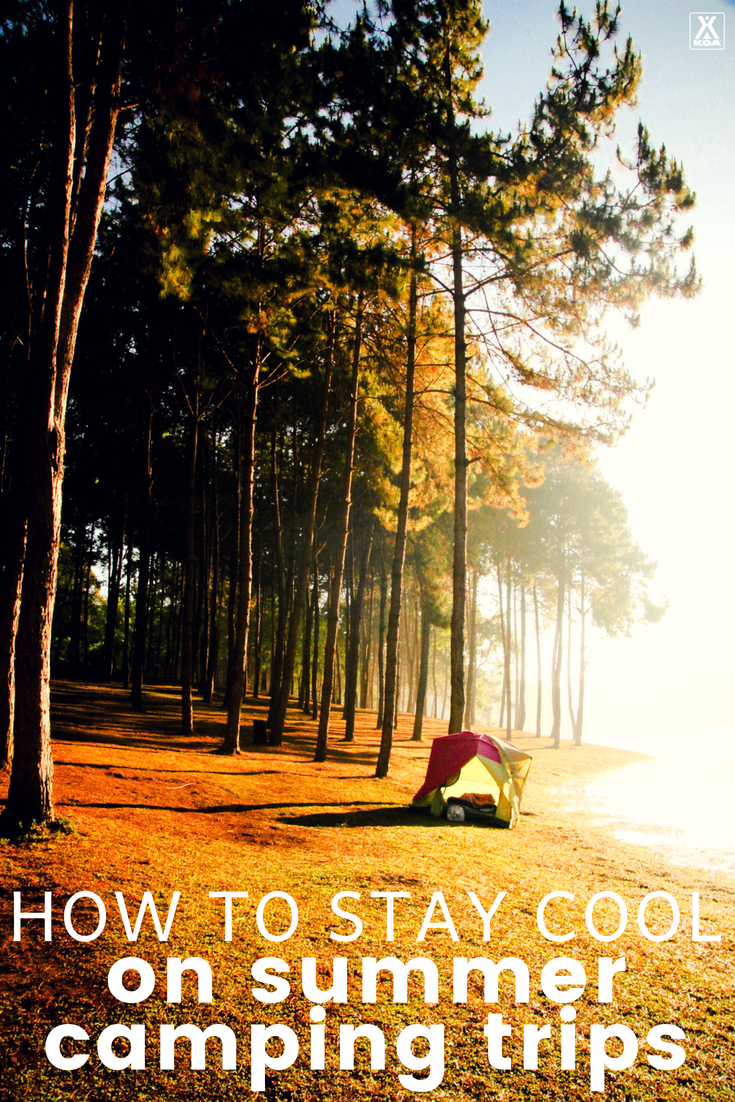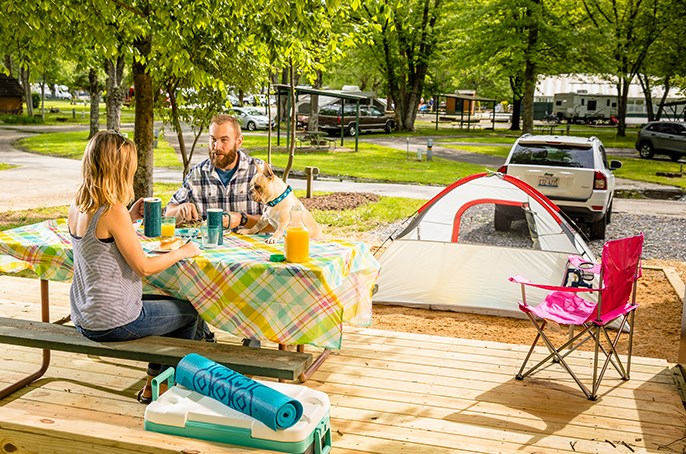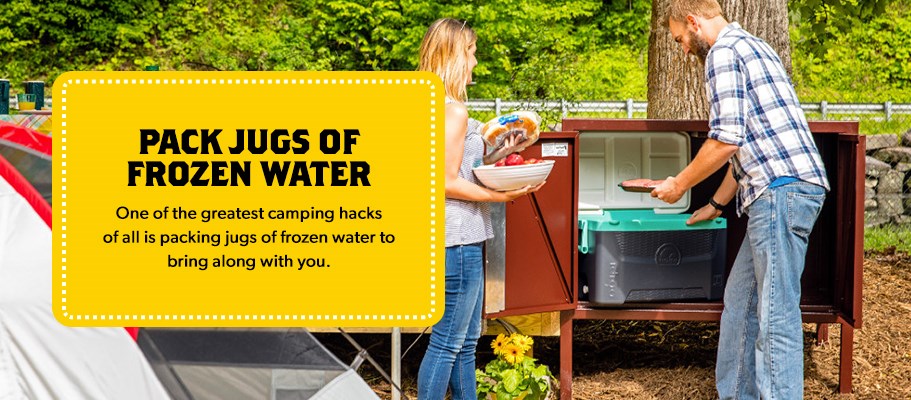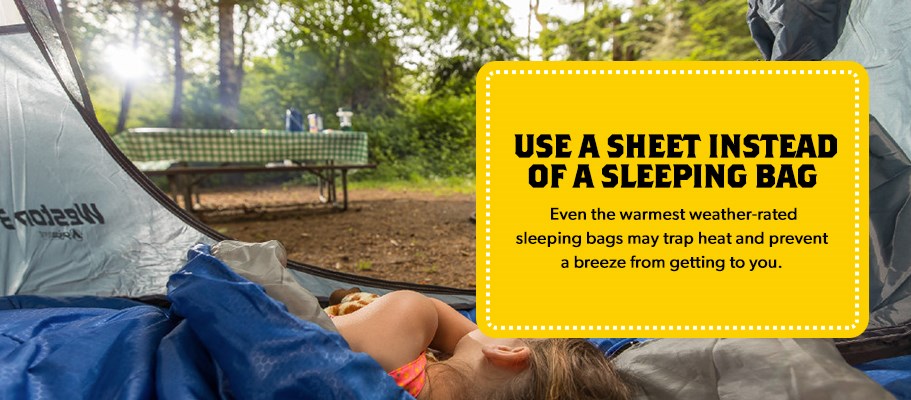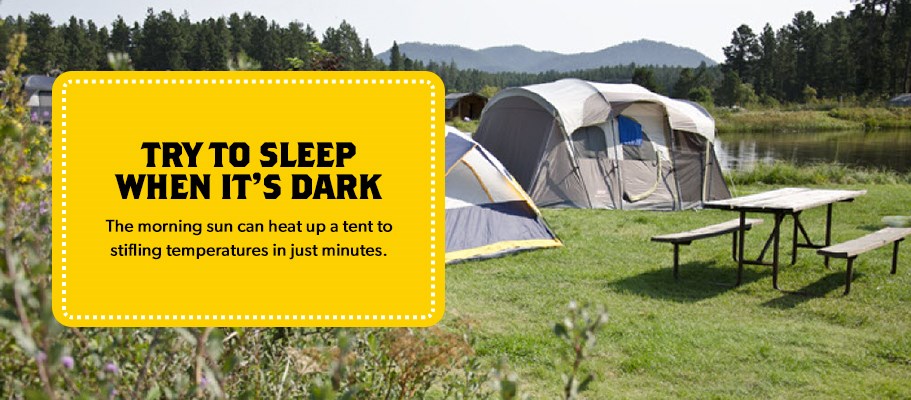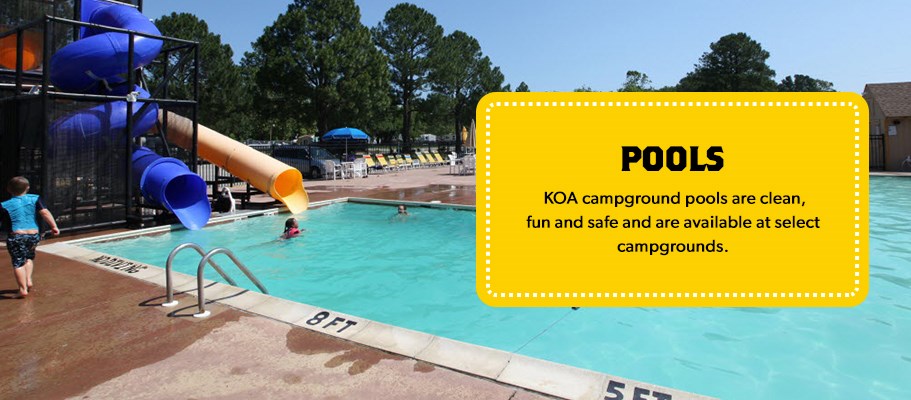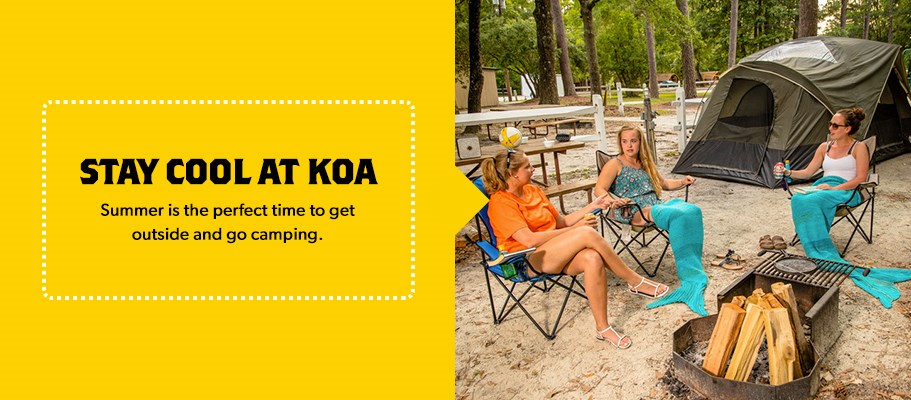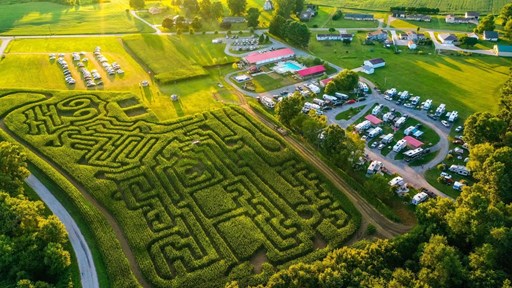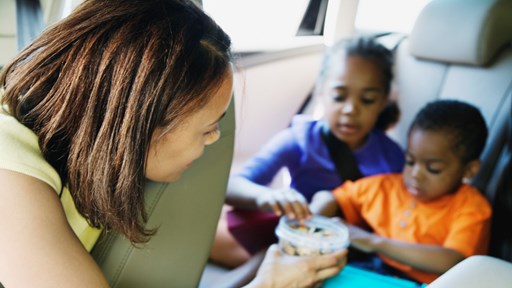How to Stay Cool While Camping
When the tilt of the earth sets our hemisphere directly in the sun’s loving gaze, that means it is time for camping. Long days, maybe some cool water to swim in, flying discs, cookouts and family fun — these are just some of the reasons so many people love summer camping.
There’s a special feeling around grabbing some clothes, packing a cooler full of food and hitting the road for the relaxing atmosphere of a campground. Make the most of your summer camping trip this year with these ways to stay comfortable and cool, even in hot, humid weather.

How to Stay Cool While Camping in a Tent
The first day of summer may be the longest day of the year, but the hottest days of the summer often come afterward — it is an effect known as the lag of the seasons. That is because the oceans are slowly stockpiling solar heat and mountain snowpack is melting, both conspiring to release their heat long after the solstice has passed.
That means finding ways to get to stay cool when camping in 100-degree weather in July, August and September. Let’s look at some of the best summer camping tips for keeping your cool.
1. Disassemble Your Tent During the Day
When it is blazing hot during the day, your tent acts like a greenhouse. It absorbs the sun’s rays and becomes a storehouse for heat, making getting back into the tent feel like stepping into a sauna.
Additionally, and perhaps more importantly, almost no fabrics fare well in exposure to direct sunlight. Synthetic tent fabric is no exception. Whether it is nylon or polyester, it is always a good idea to take your tent down during the day. Doing so will increase the life span of the tent and allow you to use it for much longer.
A good practice is to disassemble your tent after waking up and assemble it again once the sun is down. It may be a bit more work to do so, but it is worth it for both the cooler temperature and benefits to your tent.
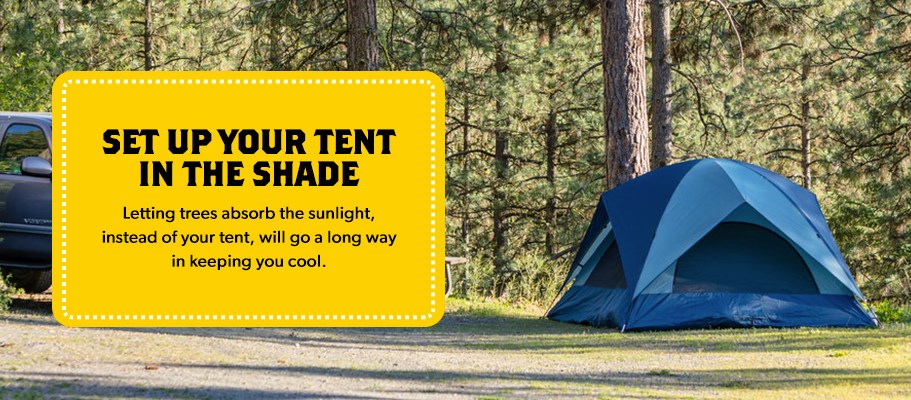
2. Set up Your Tent in the Shade
If you can find a camping spot in the shade, take it. Letting trees absorb the sunlight, instead of your tent, will go a long way in keeping you cool. The trick here is to make sure you know where the sun’s path will pass during the day.
The average latitude of the United States lies around 39 degrees north of the equator, meaning the sun will rise in the southeast and set in the southwest. Depending on where you are camping, in the middle of a summer day, it will pass anywhere from 2 to 25 degrees south of zenith — in layman’s terms, that means it will almost be directly overhead. Grab a compass, which now comes included in many smartphones, and figure out where the sun will pass in the sky.
If the trees you are parked under provide ample shade from the sun at all angles, congratulations! You may be able to leave your tent up during the day.
3. Use a Reflective Sunshade
Using a reflective sunshade is one of the best tips for staying cool while camping. These covers reflect sunlight back up to the sky, leaving anything in their shadow that much cooler. The idea when camping is to use them to block your tent or social area from the sun’s direct light. Sunshades allow you to sleep in even after the sun has come up, which any experienced camper knows is when the “sauna” effect truly comes into play.
A sunshade works best when it is significantly above the tent. Leave at least 12 inches of space between the top of the tent and the sunshade, to allow air to flow over the tent and cool things off.
Note that a sunshade does not have to be of the shiny, reflective mylar variety — though these work extremely well — but can also be as simple as a tarp. Use trees, stakes or poles to tie the shade above your tent.
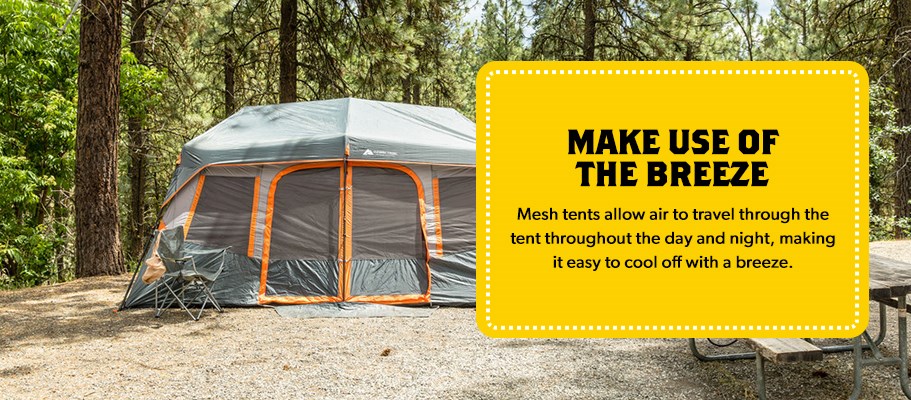
4. Make Use of the Breeze
Where you place your sleeping spot is something that you want to consider carefully. Wind is nature’s air conditioning. Even if there is not a significant breeze, making use of it is a critical move in staying cool during summer camping.
Try to pitch your tent in a spot that has shade and a constant breeze. You will stay cooler in a spot that faces into the breeze, as opposed to downwind. Mesh tents allow air to travel through the tent throughout the day and night, making it easy to cool off with a breeze. When you figure out which direction the wind will be blowing, face your tent door into the wind.
To figure out where the wind will come from, try these methods.
- Ask the locals: Campground owners and staff, full-timers or residents may have a good idea of which direction the wind blows during the night and day.
- Check the weather: Most weather Apps will indicate which direction the wind is blowing. For instance, “5 mph NNW” means the wind will be blowing at 10 miles per hour from the north-northwest. In that case, you should angle your tent so the wide side faces that direction.
- Use your finger: Wet your finger and hold it up in the air. The cold side indicates the direction the wind is blowing from.
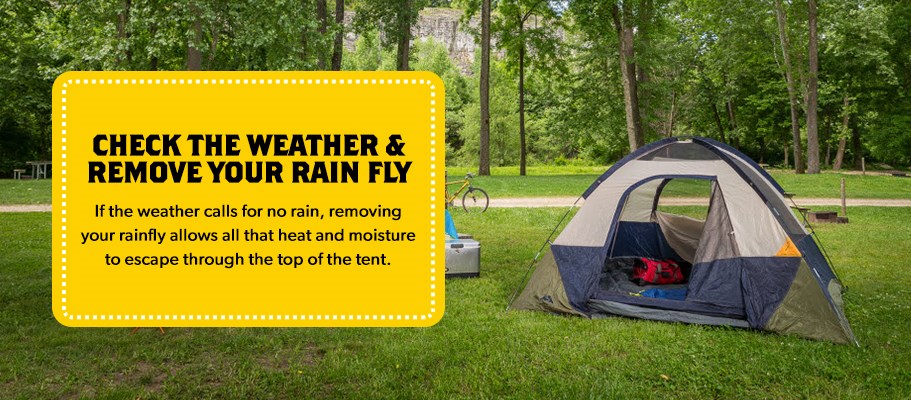
5. Check the Weather and Remove Your Rain Fly
At night, your hot breath and body heat float upward and condense on the inside of your rainfly. If the weather calls for no rain, removing your rainfly allows all that heat and moisture to escape through the top of the tent. In the summer months, this can make a huge difference in staying cool.
Note that a tarp or sun shade will not trap heat or moisture, provided it is sufficiently far above your tent. Since rain flys hug your tent, they are more prone to locking in heat. Have it on hand, however — if an unexpected rainfall happens during the night, you can quickly string it up to provide cover.
6. Choose a Tent With Lots of Mesh
Mesh tents are a miraculous chapter in the history of camping. The fine mesh walls of a tent offer protection from biting insects while also allowing a breeze to pass through, thus providing the best of both worlds to add to your warm-weather camping gear.
If you will be camping in the summer, it is advantageous to choose a tent with as much mesh as possible. Note that all tents will come with a solid, waterproof floor that extends a distance up each wall. While this wall blocks a breeze from coming through the lower parts of the walls, it also protects against the splatters of raindrops hitting the nearby earth.
7. Get a Portable Fan
Portable fans provide a blissful, battery-powered breeze that runs all night. A good camping fan will be lightweight, quiet, portable and able to attach to the tent’s floor, wall or ceiling. Find fan with foam blades, since you will be using it in close quarters. Once you discover the pleasures of having a portable fan when camping in 100-degree weather, you will never leave home without it.
8. Try Sleeping in a Hammock
Hammock camping is another level of camping altogether. If you have a couple of trees to tie a hammock between, it is a great way to get full-body air circulation and have a fun vantage point of the world around you.
Now, one of the “drawbacks” of hammock camping is that it can be quite chilly if the temperature drops or there is a good breeze. Here are some tips for hammock camping.
- Type: Make sure you buy the right type of hammock for sleeping — not lounging. A good sleeping hammock will have plenty of fabric to stretch out in, be durable enough for the conditions and lightweight enough to not be a pain.
- Insects: If you are in an area where mosquitoes like to bite, a hammock allows them easy access to your skin. To keep them away, use a bug net. Another option is to apply some bug spray on the outside of your hammock, though a bug net may be easier on the nose.
- Positioning: A hammock forces your body into a slouching hunch that is not particularly healthy for your back. To lie flat in a hammock, lie diagonally in it. If you have not tried this yet, you should — it’s quite remarkable and provides a completely flat surface for your body.
- Rain: String a tarp above your hammock to avoid getting soaked in the middle of the night.
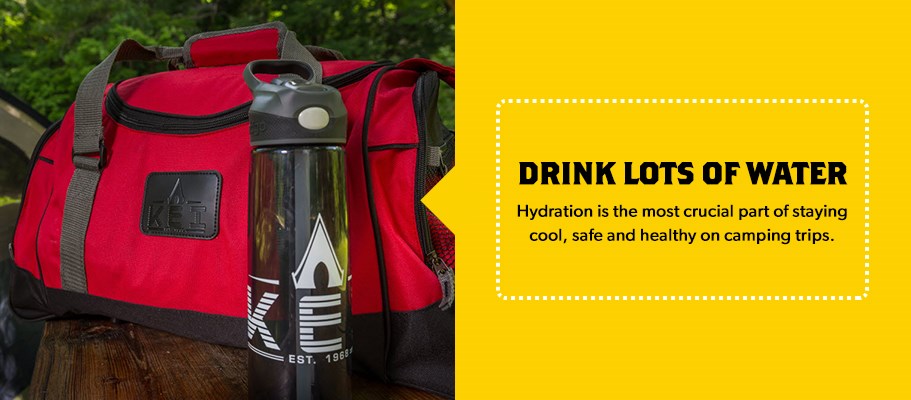
9. Drink Lots of Water
Hydration is the most crucial part of staying cool, safe and healthy on camping trips. Water has a high specific heat value, which means it takes a lot of energy to change the temperature of water. That is why water makes such a good substitute for coolant in car radiators — it is coolant. Since your body is made of about 60% water, keeping it properly hydrated is one of the best weapons against overheating.
Water is important if you are camping in hot weather. Dehydration can lead to many problems and health risks, so try to drink at least 64 ounces of water per day or more. If you are feeling thirsty, that means you are already dehydrated, so try to sip water throughout the day consistently. Before you go camping, try to get used to drinking at least eight glasses of water a day. This will give you an idea of how much water you should be drinking while enjoying the fun and sunshine on your camping trip.
10. Soak a Towel and Lay It Across Your Forehead or Neck
If it is particularly sweltering outside, laying a damp towel across the back of your neck is a great way to beat the heat during the day. At night, try soaking a small cloth in cold water and placing it across your forehead. As mentioned before, the high specific heat of water will allow it to suck quite a bit of heat out of your skin before it gets warm. When it does, just flip it over and enjoy the process all over again.
If you go for a hike, you can soak a bandana in cold water and tie it loosely around your neck. This trick has the same effect in other forms — wearing a wet shirt, soaking your hat and so on.
11. Take a Cold Shower Before Going to Sleep
If there is a shower facility or even a cool body of water nearby, try immersing yourself in it before going to bed. Cold water will bring your internal temperature down and turn your body into a self-contained air conditioning unit for a while. That means when you go to bed, you will feel cool and comfortable and will be able to fall asleep more easier.
12. Pack Only Light-Colored Clothing
There’s no way around this laws of nature — solar radiation soaks into dark-colored surfaces and reflects off light-colored surfaces. Do not try to fight it — instead, work with it by packing only light-colored clothes on summer camping trips. These will keep you much cooler during the day.
Also, choose fabrics that breathe and release heat, such as cotton and linen. Take inspiration from the traditional garb of hot places, such as the Middle East and Saharan Africa, where clothing is generally white, loose-fitting and breathable. These pieces of clothing also cover more of the body to protect against sunlight. If you are wearing short sleeves or shorts, make sure to apply plenty of sunscreen.
13. Protect Your Skin
Make sure to apply plenty of sunscreen to protect your skin from harmful ultraviolet (UV) rays. UV rays can cause premature skin aging, skin cancer, immune suppression and eye damage. Applying sunscreen regularly throughout the day will protect your skin from the sun and prevent painful sunburns. Wear a hat and sunglasses for additional protection.
14. Keep Your Food Cold
Keep your food cold while camping in the heat to maintain food safety. Invest in a high-end cooler to keep things cool, or opt for a less expensive cooler and freeze the foods you plan to take ahead of time. Whether your cooler is a high or low-end one, try to only open it when necessary. The constant opening and closing of the cooler will cause the contents to lose their cool temperature.
When choosing what food to bring on your camping trip, choose breakfast and lunch foods that do not require being cooked over a hot campfire. Using a campfire to cook your evening dinner should be fine in the heat, but certainly not during the day. Be aware that higher temperatures can increase the risk of fire dangers, so campfires are safest in the evening during summer.
Don’t forget to cool off with some nice, cold treats. Make some DIY frozen sweets to enjoy on a hot day, and use your cooler to keep them cold.
15. Pack Jugs of Frozen Water
One of the greatest camping hacks of all is packing jugs of frozen water to bring along with you. If you are car camping, bring as many of these as you can fit in your coolers. They come in handy in the following ways.
- In place of cooler ice: When you pour ice into a cooler, it melts, turns to water and must be poured out. All the while, it soaks whatever food items are in the cooler and limits the packaging you can bring. Jugs of frozen water stay contained as they melt.
- They turn into drinking water: Melted ice in a cooler may be dirty from food packaging or repeated hands sifting through it to find things. However, jugs of ice just turn into cool drinking water once they have melted. Because there is less surface area on a jug of ice, it also takes much longer to melt than ice cubes.
- Nighttime air conditioners: At night, slipping a jug of frozen or cold water into the bottom of your sleeping bag can cool your feet and make it easier to fall asleep. Use this trick when you have brought enough jugs of water to keep your food cool. If there is a cool stream or source of cold tap water nearby, however, filling a jug with it will also work to cool you down.
16. Use a Sheet Instead of a Sleeping Bag
When it is especially hot outside, a sleeping bag may not be the best choice. Sleeping bags are designed to keep you warm in freezing temperatures. Even the warmest weather-rated sleeping bags may trap heat and prevent a breeze from getting you to.
If the weather forecast calls for humidity and heat, pack an inexpensive polyester fleece sleeping bag or take a cotton sheet instead of a sleeping bag.. When placed on top of a mattress pad, this sheet can provide enough warmth for comfort, while still keeping you cool.
17. Try to Sleep During Sundown
The morning sun can heat up a tent to stifling temperatures in just minutes. To avoid growing too hot in your tent by going to bed early, it helps to get to bed early, even if this means calling it a night earlier than you might in day-to-day life. The farther north you are, the earlier the sun will rise each day. The farther south you are, the hotter it is likely to get. Balance these two factors when deciding a good sleep schedule.
18. Deter the Bugs
Make sure you pack plenty of bug spray for your camping adventure to protect yourself from harmful diseases. Insects are more active during hot summer months, but bug spray will keep buzzing pests and itchy bites from hindering your camping experience. Visit the United States Environmental Protection Agency (EPA) website to determine which bug spray is right for you.
Stay Cool and Comfortable When You Camp at Kampgrounds of America
At KOA, we have a wide variety of ways to stay cool while having summer fun. KOA offers lots of convenient amenities, different lodging options and even some water activities. Note that each KOA campground is unique — be sure to check ahead of time to see what amenities yours offers.
Here are some reasons KOA stands ahead of the rest.
Convenient Amenities
For tent camping, there is simply no parallel to KOA. Here are some amenities you will find at every KOA location:
- Level, roomy campsites
- Clean restrooms
- Hot showers
- Washers and dryers for laundry
- Picnic tables
- Fire pits or rings for s’mores, bonfires and good times
In addition to these great amenities, many KOA campgrounds also offer KOA Convenience Stores for any necessities, pet parks, playgrounds, planned activities, group camping options and water spigots near Tent Sites.
Plenty of Options When You Choose KOA
Tent camping has a special place in connecting with the outdoors, but KOA also offers other types of lodging for those looking for alternative options. Here are some of the different lodging types at KOA.
- RV Sites: Keep cool in an RV this summer. If you are looking for a spot to perch a camper, look no further than KOA. The campgrounds offer everything from basic amenities to sites with fully equipped patios. Check ahead of time to inquire about pull-thru sites, back-ins, full sewer hook-ups and 30- or 50-amp power.
- Deluxe Cabins: If staying cool in the summer heat is on your priority list, look no further than the Deluxe Cabins at KOA. Deluxe Cabins include a private bathroom, and many also offer other great features like kitchenettes, linens and more.
- Camping Cabins: These units provide comfortable lodging for those looking for a unique camping experience. KOA Camping Cabins give families and friends an occasion to bond over the outdoors while still enjoying an indoor space at night.
- Glamping Tents and Other Options: Explore glamping opportunities with quirky new options, including camping in an authentic teepee, a yurt, a train caboose, a classic Airstream camper, a treehouse or a wall tent. While these options do not exist at every KOA site, you may be surprised what’s available — check specific campgrounds to see what options they offer!
Extra Amenities
While not every KOA has the same features, many campgrounds offer the following fun activities for summer camping:
- Pools: There is no better way to stay cool when things get muggy and hot. KOA campground pools are clean, fun and safe and are available at select campgrounds. Both kids and adults love taking a dip in their clear, blue waters, as well as playing games and soaking up the sunshine.
- Activities: Some KOA campgrounds offer bike rentals, putt-putt courses, movie nights, beaches, fishing and more. Of course, for summer camping, our water activities are the perfect way to beat the heat and have fun doing it.
Stay Cool at KOA
Summer is the perfect time to get outside and go camping and check some items off your summer bucket list. KOA is the most trusted spot in America to do so. Come enjoy amenities like level campsites, accessible water sources, clean bathrooms, hot showers and gorgeous surroundings. If camping in a tent, staying cool is a matter of following these tips and remembering to prepare for the trip. Always remember hydration is the most important part of staying cool and not overheating.
Check out all the different lodging options, and come to KOA to enjoy the great outdoors.
